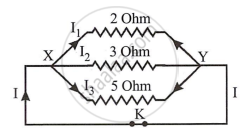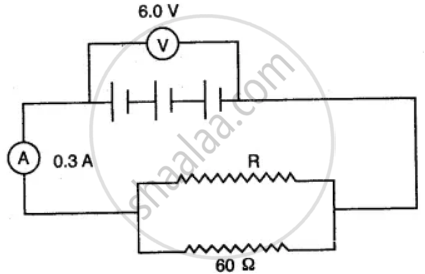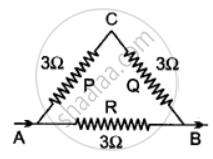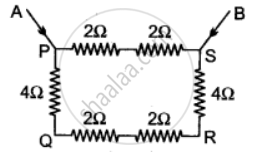Advertisements
Advertisements
प्रश्न
You have three resistors of values 2 Ω, 3 Ω, and 5 Ω. How will you join them so that the total resistance is less than 1 Ω? Draw a diagram and find the total resistance.
उत्तर
It is necessary to connect the resistors in parallel because we desire an effective resistance that is lower than the minimum value of the individual resistors.
∴ `1/"R" = 1/"R"_1 + 1/"R"_2 + 1/"R"_3`
`1/"R" = 1/2 + 1/3 +1/5`
= `(15 + 10 + 6)/30`
= `31/30`
∴ R = `30/31 < 1Ω`
R = 0.97 Ω

संबंधित प्रश्न
Which of the following arrangement, A or B, has the lower combined resistance?

Explain with the help of a labelled circuit diagram, how you will find the resistance of a combination of three resistors of resistances R1, R2 and R3 joined in parallel.
You are given three resistances of 1, 2 and 3 ohms. Shows by diagrams, how with the help of these resistances you can get:
(i) 6 Ω
(ii) `6/1` Ω
(iii) 1.5 Ω
A combination consists of three resistors in series. Four similar sets are connected in parallel. If the resistance of each resistor is 2 ohm, find the resistance of the combination.
Show how would you connect three resistors, each of resistance 6 O so that
the combination has a resistance of(a) 9 Ω (b) 4 .Ω
What are the advantages of a parallel connection?
Tick (✓) the correct choice among the following :
Consider two cases of two parallel current carrying conductors. Current in
th e same direction and currents in th e opposi te directions will produce
How does the resistance of a metallic wire depend on the length of wire?
In the figure below, the ammeter A reads 0.3 A. Calculate:
(i) the total resistance of the circuit
(ii) the value of R
(iii) the current flowing through R.

Calculate equivalent resistance in the following cases:


